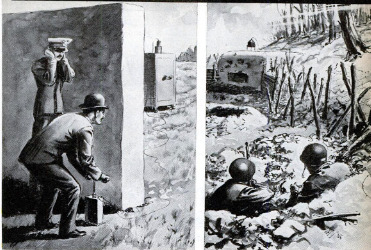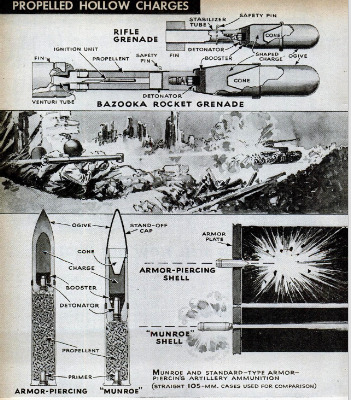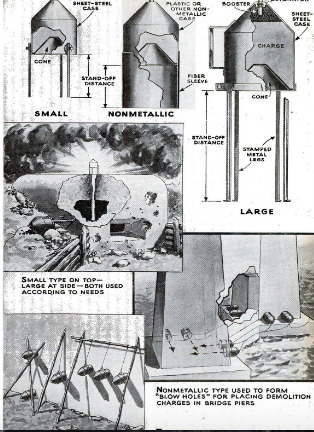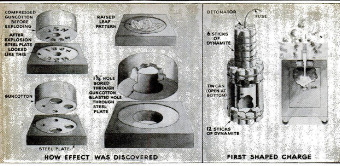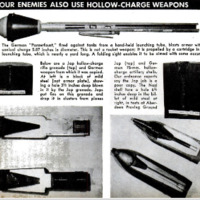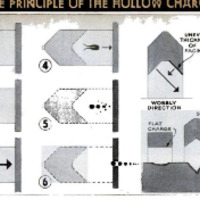-
Titolo
-
The bazooka's grandfather: it makes steel flow like mud!
-
Article Title and/or Image Caption
-
The bazooka's grandfather: it makes steel flow like mud!
-
extracted text
-
In POPULAR SCIENCE MONTHLY, 45 years
ago this month, Prof. Charles I. Munroe,
of Columbian University (now George
Washington University), reported his dis-
covery of some “curious effects produced
with ‘explosive substances,” for which he
thought useful applications might be found.
The most startling of those applications
were not discovered until after Dr. Munroe's
death in 1938; but they are proving ex-
tremely useful now, for they are enabling
Army Ordnance to design weapons to punch
holes in the thick, reinforced concrete and
the heavy armor plate behind which our
besieged enemies lurk.
The “Munroe effect” is the secret within
many secret weapons, and its utilization is
one of the most important scientific de-
velopments in the field of explosives during
this war. It gave the bazooka its terrific
wallop. And it is being used to bore into
the very foundations of the fortifications,
pillboxes, bridges, and other installations of
the Germans and Japanese.
Dr. Munroe, who also helped develop
smokeless powder, noticed this highly im-
portant peculiarity of explosives while
working at the Naval Torpedo Station at
Newport, R. I, back in the 1880's. When
guncotton was molded there, holes were
bored in each cylinder for the insertion of
a detonator. Letters and figures were also
stamped in the cakes of explosive. And, in
the course of his work, Dr. Munroe found
that when a block thus punched or indented
was placed on an iron plate and exploded,
indentations corresponding to those in the
explosive were made in the plate.
Experimentally, he placed leaves, bits of
lace, coins, and stencils between the gun-
powder and the metal plates and succeeded
in producing raised ornamental designs on
the surface of the plates by setting off the
explosive. Experimentally, too, he put sticks
of dynamite around a tin can, thus creating
a-cavity in the middle of a charge—and
found that he then could blow a hole in the
side of a heavy steel safe with much less
dynamite than would be needed if the whole
charge were placed flat against the wall of
the safe.
Dr. Munroe, in short, found a way to con-
centrate a portion of the force of an ex-
plosion on a particular spot. And that way,
which seemed curious even to him, consists
of leaving a cavity in the explosive at the
very spot where the maximum force is de-
sired. The British now call the Munroe
effect “the cavity effect of explosives,” and
American experts often describe the blocks
of explosives in which this effect is now
used as “hollow” or “shaped” charges.
A Norwegian investigator had suggested
much earlier that air space might be used
to enhance an explosive's effect. The idea
was taken to Germany in the 19th century,
and applied in the mines in the Saar region,
but did not catch on among German military
men. A patent on an application of the idea
was issued in Germany in 1910, and another
patent was issued in Britain in 1911, but no
nation did much with the idea during World
War I. Interest in Dr. Munroe's principle
was revived, however, a few years ago, and
his work now has been continued by the
Research and Development Service of the
U.S. Army Ordnance Department with
many remarkable results.
The Munroe effect may be obtained with
any kind of high explosive by cutting a
cavity of almost any size or shape in the
side of the charge that is placed toward the
object to be cut or punctured. Miners have
been known to arrange sticks of dynamite
in the shape of a tepee to blow a hole in
the ground. And demolition engineers some-
times have taken a jackknife and cut a little
chunk out of a block of dynamite before
placing it against an object to be severed.
But, to attain the full benefit of the
Munroe effect, the cavity must be shaped
scientifically, a lining of the correct kind
of material must be placed in this cavity,
the charge must be held a certain distance
from the object against which its force is
to be directed, and the detonation of the
explosive substance should begin at its rear.
No simple rule is known yet by which the
effectiveness of certain size or shape of
cavity in different weights, shapes, and
varieties of explosive charges can be pre-
dicted. By dint of much research, however,
the Ordnance Department has provided our
Army with a wide variety of hollow charges
that can be counted on to produce definite
results.
U.S. Army engineers, for example, use
demolition charges that look like thick,
stubby cones. These are placed in light
metal cans, or even more fragile containers,
with legs or rims to hold the large end of
the cone a suitable distance from the sur-
face to be hit with the maximum explosive
force. The charge is then detonated from
the opposite, or pointed, end of the cone.
‘When it is touched off, a detonation wave
races through the explosive substance. This
is a chemico-physical wave that progresses
from layer to layer of molecules, causing
them to vibrate
and disintegrate. In TNT, this wave may
travel five or six miles a second, and in some
other explosive substances it goes even
faster. It can jump across short air gaps,
yet sometimes can be stopped with surpris-
ing ease by interposition of a comparatively
thin layer of some sturdy material. The
turmoil of the explosives molecules, as the
wave progresses, creates force, which moves
outward at right angles to the surfaces of
the charge.
In the hollowed-out portion of a shaped
charge, this force coming from the sides of
the cavity is concentrated into a jet. This
jet has greater energy, pressure, and heat
than the force that emerges from the flat,
outer sides of the charge. The explosive
waves are merged and focused as though
they were streams of water, or rays of light,
or waves of sound—and their effectiveness
is greatly enhanced.
By changing the shape of the conical
cavity, the width of the jet can be varied.
A shallow cone, for example, causes a fairly
wide jet and a deep one causes a narrow and
more intense jet. Hence, one type of cone
is used to punch a wide but shallow hole in
an object, and another type to create a deep,
‘tubular hole,
Suppose now, that, in addition to the
waves of hot gases and explosive force
spurting from a charge, pellets or frag-
‘ments of metal were included in the jet. The
destructiveness of the jet obviously would
be made even greater. And this is exactly
what has been accomplished by placing suit-
able linings, made of thin metal or some
other material, in the conical cavities of
shaped charges.
Linings have been developed which are
literally turned inside out by the concen-
trated explosive force. When thus turned
about they become teardrop-shaped pellets
which are driven into the target. Other
linings are tor into tiny fragments quickly
by the explosive force and those fragments
are hurled at the target. As visualized by
ordnance experts, the tiny fragments lead
the way, followed by larger ones, and thus
a hole is punched in the target that grows
wider as the Jet continues on its swift, de-
structive way.
With a shaped charge of TNT weighing
only 10 pounds, a hole 1 1/4 inches wide can
be blown through eight inches of steel
armor plate, or a hole twice that wide can
be punched through a 30-inch reinforced-
concrete slab. And, by firing a second
shaped charge of TNT at the same spot,
that hole can be widened and deepened.
Such invasions of armor and concrete are
possible with the smallest of three standard-
shaped charges supplied to the engineers
for demolition blasting. By using a slightly
bulkier, but no heavier, shaped charge of a
new explosive mixture that is more power-
ful than TNT, the wreckers can blow a
wider and deeper hole in either steel or con-
crete with a single explosion.
And, for really tough demolition jobs, the
engineers use a heavier shaped charge. One
blow from this one will punch a hole
through five feet of reinforced concrete. If
that concrete is part of a pillbox, the in-
terior will be filled with bits of metal, hot
gases, torn-off chunks of concrete, and other
flying debris that will make life unendur-
able for the occupants. And if this violence
is not sufficient, a long, narrow bangalore
torpedo or a flame thrower can be shoved
through the hole left by the shaped charge
and used to complete the destruction of the
occupants of a pillbox.
If Japs are hidden beneath log or steel-
drum bunkers, ome of these big shaped
charges can be set on top of their cubby-
hole and detonated. The charge will com-
pletely penetrate four feet of earth and four
layers of 12-inch logs, sending hot metal
fragments into the emplacement and filling
it for five minutes with highly disagreeable
smoke, debris, and dust.
If a more massive concrete obstacle must
be removed, an engineer can set one of his
big shaped charges against it and produce a
hole about 60 inches deep, five inches wide
at its mouth, and three inches wide at its
bottom. A hole that size is plenty big
enough for the insertion of more explosives
to do whatever additional damage is desired.
Yet the shaped charge makes such an open-
ing as readily as you can drive a needle into
loose sand.
These shaped charges, moreover, need
not be clamped tightly against the surface
that is to be punctured. The Germans have
put magnets on the sides of some of their
hollow charges to hold the charges against
metallic plates. But if a horizontal surface
is to be punched, the weight of the shaped
charge is sufficient to hold it in place. If a
hole is desired in a vertical wall, the shaped
charge can be propped against the wall with
a light pole, or hung from a wire like a
picture frame.
But shaped charges need not always be
carried to their target by hand. They can
also be conveyed in rockets. In fact, one of
the most important applications of the
Munroe effect is in giving relatively slow-
moving rocket projectiles the penetrating
power of high-speed shells.
The army ordnance bazooka projectile,
for example, is a rocket containing a shaped
charge. The striking end of the projectile
is hollow, and behind this open space is the
wide end of a cone. Back of this cone is the
explosive. It is detonated by a fuse in the |
rear, and the explosive force is shot forward |
after the rocket has hit. This concentration
of the force enables a man armed with a
bazooka to shoot a hole in the side of a
heavy tank. The design of the high-explo-
sive end of big rockets is similar. |
In a rifle grenade, too, the Munroe prin-
ciple is applied. The forward end of the
grenade is left hollow, and the explosive's
force is focused on the target by a come.
The use of this principle in ammunition,
however, is not limited to rockets and gre- |
nades. It also is used advantageously in
artillery ammunition. But this poses a prob-
lem that is almost the reverse of that en-
countered in designing other armor-piercing |
shells.
A standard type of armor-piercing pro-
jectile has a heavy steel nose and is shot
from the gun with such tremendous ve-
locity that this nose is driven through the
armor before the explosive charge in the
base goes off. But ammunition in hich the
Munroe effect is utilized has a hollow nose,
which crumples when it hits the armor.
The cone behind this nose then focuses the
explosive force against the armor.
So, in designing the latter type of shell,
the problem is to build a nose that will
crumple just the right amount when it hits
the armor, rather than one that will go
through the armor. Unless the nose
crumples exactly the right amount, the hol-
low charge will be detonated too near or too
far from the surface of the armor, and the
result may not be satisfactory.
The distance between a hollow-charge ex-
plosive and its target at the time of detona-
tion is known as the stand-off distance.
Experience has shown that it is highly im-
portant. When this distance is exactly right,
the jet from a hollow charge hits with such
tremendous force that it actually makes
steel flow like thick mud.
Much depends, too, on the type and thick-
ness of the cone’s lining. If that lining is a
few hundredths of an inch thicker in one
place than in another, and hence a bit more
resistant to the explosive force on one side
of the cone than on the other side, the jet
will wobble and lose part of its force.
Similarly, a crack or very slight uneven-
ness in the shape of the cone or its lining
‘may greatly reduce the Munroe effect. Even
tie Speed with ‘Whivh the detonating Wave
starts through the charge is an important
factor.
World War II has been partly a race be-
tween United Nations and Axis experts to
learn more about the best ways to deter-
mine and regulate stand-off distances and
to find the most efficient linings for the
cavities of hollow charges. It has been a
quest for precision. This race has been run
by ordnance researchers, however, without
benefit of cheers from the public, lest pre-
mature revelation of some bits of informa-
tion help the foe to catch up. Tests that
have been made with German and Japanese
hollow-charge explosives indicate that the
Allied ordnance experts are well ahead of
their rivals.
The engineers’ uses for shaped charges
are manifold. Assume, for a moment, that
a bridge must be cut. It can be done either
by severing one or more spans or by knock-
ing out supporting pillars. In either case,
hollow charges can be helpful. They can be
used to weaken a span by punching holes in
it. But spans usually can be replaced more
quickly than supporting pillars. So the engi-
neers may choose to demolish the pillars.
They can do this by punching holes in them
with hollow charges, filling those holes with
additional explosives, and thus leaving the
whole bridge shattered as irreparably as
Humpty Dumpty.
You may wonder, when you observe the
shape of a hollowed demolition charge
placed against a sturdy obstacle, why it
does not simply fly off like a rocket when
detonated. The experts’ answer is that the
explosive force is spent too swiftly, and is
countered too effectively by the emergence
of other force from other sides of the
charge. The distance that a demolition engi-
neer must stand back for safety's sake,
when detonating his shaped charge, depends
partly on the composition of his container—
and this is another matter which has been
the subject of research.
The extent to which the wild forces of an
explosive wave can be focused, however, is
truly astounding. If, for instance, a hollow
charge with a deep cone such as is used for
demolition work is turned toward the sky
and shot off at night, the result is a pillar
of brilliant, flaming gases, almost as slender
as a bolt of lightning, but as straight as the
beam from a searchlight.
-
Autore secondario
-
Volta Torrey (article writer)
-
B. G. Seielstad (illustrator)
-
Lingua
-
eng
-
Data di rilascio
-
1945-02
-
pagine
-
65-69, 211,216
-
Diritti
-
Public domain
-
Archived by
-
Sami Akbiyik
-
Marco Bortolami (editor)
